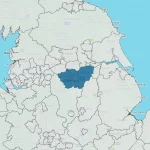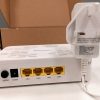Gov Ponders Broadband Satellites on Churches to Fix UK Rural Coverage
A new report claims that the Government is considering the installation of broadband Satellite dishes on church spires, which could be used to help expand faster broadband connectivity into the most remote rural communities around the United Kingdom.
The idea of using church spires to expand broadband connectivity is nothing new and a number of ISPs, such as WiSpire in Norfolk, have been doing something similar for a fair few years’ by installing discreet WiFi style Fixed Wireless Access (FWA) technology on top of churches.
However most of the ISPs that do this tend to supply the service via either a fixed line link or point-to-point Microwave (Radio) connection, while the Telegraph claims that the Government are pondering the cheaper approach of using a Satellite link (we assume for supplying capacity to a fixed wireless network). But this can result in an inferior service that suffers from restrictive data allowances and very high latency times, which is far from ideal.
Advertisement
On top of that people can already order Satellite broadband connections of their own via a large number of ISPs (here), many of which can now be subsidised by various voucher schemes to help remove the hefty installation / setup cost.
Matt Hancock, UK Digital Minister, said:
“Getting to the hardest to reach places requires an innovative approach and a mix of technologies. We’re working with the church to explore how spires might form part of the mix and I am meeting with bishops later this month to discuss this.”
The newspaper claims that the Church of England has offered use of its 16,000 churches to help the Government deliver on its promise to bring “superfast broadband” (24Mbps+) to 95% of properties by 2017/18, although we already know that the existing contracts should ultimately reach 97% of the country by 2020.
In other words, it’s more likely that the latest discussions are intended to help with the final 3% of UK premises (these are usually disproportionately expensive to upgrade via fixed lines) instead of the next 95% coverage goal or the later 97% aspiration, as those are already being tackled.
Apparently part of the idea is agree a standard contract for the new Satellite based approach and thus Matt Hancock intends to meet with a number of religious figures later this month to discuss the idea.
Advertisement
This is probably just one of a series of options that the Government are considering, which will no doubt play into their tentative plans for a new rural broadband voucher scheme (here) and / or the proposed 10Mbps Universal Service Obligation (details).
BT has previously offered to help deliver most or all of the new USO (here), such as via new fixed line solutions like Long Range VDSL / FTTC. However even BT would struggle to connect those in the final 0.5-1% of UK premises via fixed line solutions and, without more public funding, a Satellite quick-fix would appear to be very likely.
Mark is a professional technology writer, IT consultant and computer engineer from Dorset (England), he also founded ISPreview in 1999 and enjoys analysing the latest telecoms and broadband developments. Find me on X (Twitter), Mastodon, Facebook, BlueSky, Threads.net and Linkedin.
« BT Openreach Start Pilot of 330Mbps G.fast Broadband for 138000 UK Premises
The 2017 UK Best Home Broadband ISP Picks by ISPreview.co.uk »

















































Comments are closed